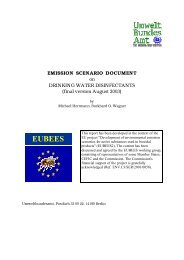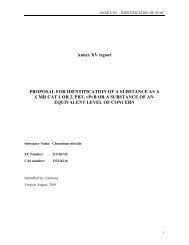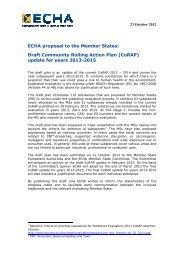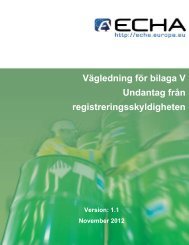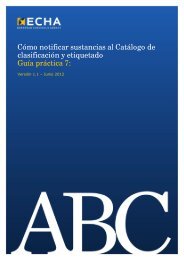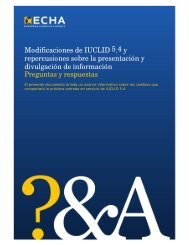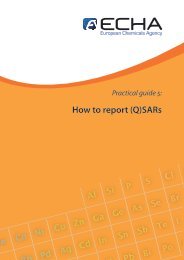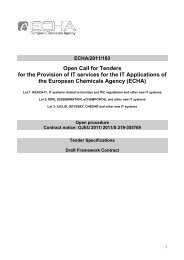Strategy For Limiting Risks Human Health Draft of ... - ECHA - Europa
Strategy For Limiting Risks Human Health Draft of ... - ECHA - Europa
Strategy For Limiting Risks Human Health Draft of ... - ECHA - Europa
Create successful ePaper yourself
Turn your PDF publications into a flip-book with our unique Google optimized e-Paper software.
presumption the critical air concentration <strong>of</strong> cryolite would be 1.03 mg cryolite/m 3 for<br />
workers inhaling 10 m 3 per shift and taking into account the F⎯ content <strong>of</strong> cryolite and<br />
assuming 90 % absorption by inhalation (5 mg F⎯ x 100/54 cryolite/F⎯ / 0.9 / 10 m 3 ).<br />
The German MAK-value for fluoride has recently been set to 1 mg F⎯/m 3 (DFG 2005). It is<br />
recognised that application to cryolite would reveal an air concentration <strong>of</strong> 1.9 mg cryolite/m 3<br />
(1 mg F⎯ /m 3 x 100/54 cryolite/F⎯).<br />
The human NOAEC <strong>of</strong> fluoride for workers <strong>of</strong> 0.48 mg F⎯ which corresponds to about 0.89<br />
mg cryolite/m 3 , and the reference value for fluoride from the WHO which corresponds to<br />
about 1.03 mg cryolite/m 3 are quite similar. In this report for risk assessment at the workplace<br />
a value <strong>of</strong> 1 mg cryolite/m 3 is used as critical exposure level. Additional assessment factors<br />
for worker risk assessment are not deemed necessary. The reference MOS is 1. Borderline<br />
scenarios are included in the concern range taking into account that no specific precautionary<br />
elements have been included in inhalation risk assessment.<br />
As can be seen from table 2.3 air concentrations <strong>of</strong> cryolite in the aluminium industry and<br />
during use in other industries clearly exceed the critical exposure level thus giving reason for<br />
concern. During production <strong>of</strong> synthetic cryolite exposure may occur against dust or granules,<br />
the latter one giving lower air concentrations. In both cases however there is reason for<br />
concern. The same holds true for grinding activities. By two methodical approaches a<br />
spectrum for the exposure data is given, which results at the upper end in a borderline<br />
scenario. These risks should not be neglected.<br />
In summary concern is to be expressed for all scenarios (1 – 4). <strong>For</strong> grinding activities under<br />
certain conditions risks can be excluded.<br />
Dermal contact<br />
20<br />
Conclusion: iii<br />
No specific data are available to assess the systemic toxicity <strong>of</strong> cryolite after repeated dermal<br />
contact. <strong>For</strong> a first approximation also the maximum additional fluoride intake <strong>of</strong> 5 mg<br />
F⎯/person or 0.07 mg F⎯/kg is used as reference (see inhalation exposure). Taking into account<br />
the F⎯ content <strong>of</strong> cryolite and assuming 10 % skin absorption results in an exposure level for<br />
workers <strong>of</strong> 92 mg cryolite/person/day (5 mg F⎯ x 100/54 cryolite/F⎯ / 0.1) or 1.3 mg<br />
cryolite/kg/day as starting point for risk assessment. Since additional assessment factors for<br />
worker risk assessment are not deemed necessary this value similarly resembles the critical<br />
dermal exposure level. The reference MOS is 1.<br />
According to table 2.3 for production <strong>of</strong> cryolite (scenario 1) and the use <strong>of</strong> cryolite in the<br />
aluminium industry (scenario 2) the dermal exposure is low enough to be out <strong>of</strong> the concern<br />
range. However with a MOS <strong>of</strong> 1.1 in scenario 2 it is still very close. <strong>For</strong> the other scenarios a<br />
MOS below 1 gives clear indication for concern. It should be kept in mind though, that the<br />
uncertainty <strong>of</strong> the assessment is high because for dermal absorption <strong>of</strong> the dusty material a<br />
value <strong>of</strong> 10 % is assumed without data. As way forward, robust information on dermal<br />
absorption <strong>of</strong> fluoride from solid cryolite could significantly improve the risk assessment.<br />
Conclusion: iii






